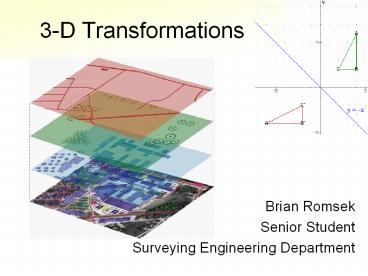3-D Transformations - PowerPoint PPT Presentation
1 / 23
Title:
3-D Transformations
Description:
3-D Transformations Brian Romsek Senior Student Surveying Engineering Department Three-Dimensional Conformal Coordinate Transformation Applications of 3D Conformal ... – PowerPoint PPT presentation
Number of Views:114
Avg rating:3.0/5.0
Title: 3-D Transformations
1
3-D Transformations
- Brian Romsek
- Senior Student
- Surveying Engineering Department
2
Three-Dimensional Conformal Coordinate
Transformation
- Converting from one three-dimensional system to
another, while preserving the true shape. - This type of coordinate transformation is
essential in analytical photogrammetry to
transform arbitrary stereo model coordinates to a
ground or object space system. - It is often used in Geodesy to convert GPS
coordinates in WGS84 to State Plane Coordinates.
3
Applications of 3D Conformal Coordinate
Transformations
- Mobile mapping systems
- Relations between different coordinate frames
- Sensor frame
- Body frame
- Mapping frame
4
Applications of 3D Conformal Coordinate
Transformations
- Homeland security
- E.G., facial pattern recognition
- Image processing
5
3D Conformal Coordinate Transformation
- Also known as the 7 Parameters transformation
since it involves - Three rotation angles omega (?), phi (?), and
kappa (?) - Three translation parameters (TX, TY,TZ) and
- a scale factor, S
6
Rotation angles Omega
In general form In matrix form More
concisely
7
Rotation angles Phi
In general form In matrix form More
concisely
Z-axis
X-axis
8
Rotation angles Kappa
In general form In matrix form More
concisely
Z-axis
X-axis
9
Combined Rotation Matrix
If we combine all the rotation matrices MG
becomes, after multiplication
10
COMPUTING ROTATION ANGLES
- If rotation matrix known, rotation angles can be
computed as shown on the right
11
Properties of rotation matrix
- The rotation matrix is an orthogonal matrix,
which has the property that its inverse is equal
to its transpose, or - This can be used for inverse relationship
12
Three-Dimensional Conformal Coordinate
Transformation
- Finally the 3D Conformal Transformation is
derived by multiplying the system by a scale
factor s and adding the translation factors TX,
TY, and TZ. - Where
13
BURSA-WOLF TRANSFORMATION
- Geodesy assumption rotation angles small
- cos ? 1
- sin ? ? (radians)
- Product of two sines 0
- Rotation matrix R becomes
14
BURSA-WOLF TRANSFORMATION
- 3D similarity transformation
- Observation Equation
15
BURSA-WOLF TRANSFORMATION
- Coefficient matrix, B
- Vector of parameters, ?, and discrepancy vector, f
16
Three Dimensional Coordinates Transformation
General polynomial approach transformation is
not conformal
17
Three Dimensional Coordinates Transformation
Alternative that is conformal in the three planes
18
Three Dimensional Coordinates Transformation
- Polynomial projective transformation, 15
parameters
19
Testing 4 Methods
- Bursa Wolf
- Linear model assume small rotation angles
- Best for satellite to global system
transformations - Bazlov et al determined PX 90 to WGS 84
parameters
- Generalized Bursa Wolf
- Linear model errors in both observations and
model parameters - Useful transforming classical to space-borne
(Kashani, 2006)
20
Testing 4 Methods
- Polynomial
- 1st order
- Useful when coordinate systems not uniform in
orientation or scale - Rubber-sheeting
- Expanded Full- Model
- Photogrammetric approach
- Angles not considered small
- Non-linear requires a priori estimate of
parameters
21
Expanded Full-Model
- Employed method shown in Photogrammetric Guide
by Abertz Kreiling - X, Y, Z coordinates translated to relative values
based in mean coordinates
22
3D Transformations Testing
- Data include a set of know control points,
transformed from WGS84 system to State Plane
Coordinates.
23
Test Results
Reference Variance































